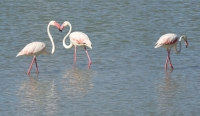Bathing in flamingo tales
 Share on Facebook
Share on Facebook
 By Rhona Wells
By Rhona Wells
The bay of Calpe with the vigilant rock of Ifach has been a landscape appreciated since ancient times. The Roman site of Baños de la Reina in Calpe forms an exceptional coastal enclave.
After the passage of centuries, the popular imagination inherited the ancient legend of the pools as the “baths of the Moorish queen”. The existence of the large basins in the sea, carved into the indigenous Tosca stone, led to the naming of the archaeological site, Baños de la Reina or Birthplace of the Queen.
The Baños de la Reina site consists of three parts:
Roman Vicus
The Roman site of Baños de la Reina is a coastal enclave renowned for its mosaics, one of the most important collections of its kind in all of Roman Hispania. During the 1st and 2nd centuries AD, the Romans constructed the first homes alongside a small thermal complex known as the “Muntanyeta thermal baths”. At the end of the 3rd century AD, a luxurious villa with a circular patio grew up around the baths, fitted with an extraordinary private thermal complex.
Muntanyeta or thermal complex
In 1993, the remains of the “Muntanyeta thermal baths”, were discovered. Various pools had survived, as well as a natatio with cold water (frigidarium). Next to these were a number of ancient ovens, which had been responsible for maintaining the appropriate temperatures in the hot rooms (caldarium) and warm rooms (tepidarium). The heating system developed by Roman engineers used hollow floors elevated by columns of bricks (pilae) and walls with air chambers made from ceramic tubes (tubuli). The entire complex was richly decorated with grey marble plates from Algeria, evidence of which remained.
The Roman Fish Farms
Various pools have survived around the Tosca stone basins allowing fish farming to thrive down the centuries. This activity was combined with the celebrated salt production, that achieved its greatest splendour in the 2nd century AD.
The Salinas de Calpe - the area’s salt flats - were eventually supplying over 40 municipalities, but their decline became evident, towards the end of the 18th century, when the surrounding waters become infected with disease. Despite various enthusiastic efforts to revive the trade, the exploitation of Calpe’s salt flats ended in the late 1980s.
As well as the fascinating area of Baños de la Reina, the Salinas de Calpe provide a natural habitat for many migratory birds, especially flamingos. In recent years, 176 different species have been spotted on the Flats where the shallow water levels provide an ideal habitat ideal for wading birds.
Most of the flamingos to be seen in Calpe today are from the Camargue area of France or the Fuente de Piedra lagoon in Malaga. They thrive on the extensive salt flats where they breed and feed. Their bent bills allow them to feed on small organisms—plankton, tiny fish, fly larvae etc. The shrimplike crustaceans that thrive in the lakes form an important part of the flamingo diet and are responsible for the birds striking pink plumage.
Unnoticed by human visitors, but not the waterfowl, a resurgence of brine shrimps has recently been detected in the salt beds, after an absence of some years. According to a local municipal biologist, this demonstrates that the Salinas are in optimum environmental condition.
The flamingos find safety in numbers, which helps to protect individual birds from predators while their heads are down in the mud. Once mating is complete, a pair will take turns incubating their single egg. Young flamingos are born grey and white and do not turn pink for at least two years.
A circular walking trail surrounds the salt flats that were declared a protected maritime -terrestrial zone in 1993. Unfortunately, being so close to the roads, lots of unwanted rubbish collects in the vegetation, casting a pall over this avian paradise. Last year, 40 volunteers helped clean up the Salinas, collecting between them and impressive 1,000 kilos of waste from the area.
